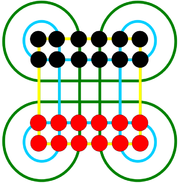
Surakarta (game)
Encyclopedia

Abstract strategy game
An abstract strategy game is a strategy game, aiming to minimise luck, and without a theme. Almost all abstract strategy games will conform to the strictest definition of: a board or card game, in which there is no hidden information, no non-deterministic elements , in which two players or teams...
game
Board game
A board game is a game which involves counters or pieces being moved on a pre-marked surface or "board", according to a set of rules. Games may be based on pure strategy, chance or a mixture of the two, and usually have a goal which a player aims to achieve...
for two players, named after the ancient city of Surakarta
Surakarta
Surakarta, also called Solo or Sala, is a city in Central Java, Indonesia of more than 520,061 people with a population density of 11,811.5 people/km2. The 44 km2 city adjoins Karanganyar Regency and Boyolali Regency to the north, Karanganyar Regency and Sukoharjo Regency to the east and...
in central Java
Java
Java is an island of Indonesia. With a population of 135 million , it is the world's most populous island, and one of the most densely populated regions in the world. It is home to 60% of Indonesia's population. The Indonesian capital city, Jakarta, is in west Java...
. The game features an unusual method of capture which is "possibly unique" and "not known to exist in any other recorded board game."
Surakarta is also among the traditional board games
Board game
A board game is a game which involves counters or pieces being moved on a pre-marked surface or "board", according to a set of rules. Games may be based on pure strategy, chance or a mixture of the two, and usually have a goal which a player aims to achieve...
played in rural China and Korea
Korea
Korea ) is an East Asian geographic region that is currently divided into two separate sovereign states — North Korea and South Korea. Located on the Korean Peninsula, Korea is bordered by the People's Republic of China to the northwest, Russia to the northeast, and is separated from Japan to the...
.
The real name of the game is "Permainan" (meaning the game in Bahasa Indonesia
Indonesian language
Indonesian is the official language of Indonesia. Indonesian is a normative form of the Riau Islands dialect of Malay, an Austronesian language which has been used as a lingua franca in the Indonesian archipelago for centuries....
). It was first published in France in 1970 as "Surakarta". The game is called "Roundabouts" in Sid Sackson's The Book of Classic Board Games. The Chinese name is 田螺旋棋 (Tian spiral chess) or 旋轉棋 (Spin chess). The Korean name is 자전거고누.
Equipment
Traditionially, Indonesian game pieces are shells versus pebbles or stones, and the board shape is inscribed in sand or volcanic ash when the game is played. But any easily-distinguished sets of pieces may be used (e.g. red and black counters or checkersEnglish draughts
English draughts or checkers , also called American checkers or straight checkers or in Israel damka, is a form of draughts board game. Unlike international draughts, it is played on an eight by eight squared board with twelve pieces on each side...
, as illustrated). Players begin the game with 12 pieces each.
Rules
Players decide who moves first, then play alternates between the players. The object of the game is to capture all 12 of the opponent's pieces (or alternatively, have more pieces remaining on the board than one's opponent when no further captures can be made). Pieces always sit on a point of intersection of the board's grid lines.On a turn, a player either moves one of his pieces a single step to an unoccupied point in any direction (forwards, backwards, sideways, or diagonally), or makes a capturing move special to Surakarta.
Capture move
A capturing move consists of traversing along an inner or outer circuit (colored blue or green in the illustration) around at least one of the eight corner loops of the board, followed by landing on an enemy piece, capturing it. Captured pieces are permanently removed from play.So, corner loop(s) are only used when making a capture. The capturing piece enters (and leaves) the circular loop via a grid line tangent to the circle. Any number of unoccupied points may be traveled over, before or after traversing a corner loop. An unoccupied point may be traveled over more than once during the capturing piece's journey. Only unoccupied points may be traveled over; jumping over pieces is not permitted.
Capturing is always optional (not mandatory).
End of game
An individual game is won, when a player captures all 12 of his opponent's pieces. Or if neither side can make headway, the game is ended by agreement and the winner is the player with the greater number of pieces remaining on the board.Scoring
A match usually consists of more than one game. Players agree ahead of time how the winner will be determined. A couple methods are typically used:- Players agree to play a fixed number of games.
- Each game is scored by the number of pieces remaining after each game. The winner is the player with higher total points after all games are complete.
- Players agree to play to a fixed number of points.
- New games are played until one player reaches or exceeds the winning point total.
External links
- Surakarta rules at Mastergames.com
- Ludoteka.com play Surakarta online

